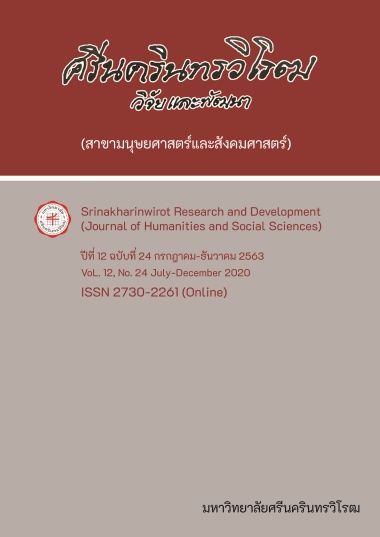รูปแบบความสัมพันธ์เชิงสาเหตุของทฤษฎีรวมการยอมรับและการใช้เทคโนโลยีที่มีผลต่อพฤติกรรมการสื่อสารภายในองค์กรผ่านโซเชียลมีเดียของข้าราชการโรงเรียน เตรียมทหาร สถาบันวิชาการป้องกันประเทศ CASUAL RELATIONSHIP MODEL OF UNIFIED THEORY OF ACCEPTANCE AND USE OF TECHNOLOGY ON COMMUNICATION BEHAVIOR IN ORGANIZATION THROUGH SOCIAL MEDIA OF ARMED FORCES ACADEMIES PREPARATORY SCHOOL
Keywords:
Causal Relationship Model, Unified Theory of Acceptance and Use of Technology, Internal Communication, Structural Equation Modeling, Social MediaAbstract
This research aimed to develop the causal relationship model of unified theory of acceptance and use of technology on communication behavior in organizations through social media and verify the conformity of the causal relationship model that has been developed with empirical data. The sample group in this research included 400 officers of Armed forces academies preparatory school. That used the LINE application for internal communication, selected by using the simple sampling method. A questionnaire composed of the 7 scale, with reliability at 0.97, was applied to collect the data. The data were analysis by structural equation modeling. The findings were as follows: the causal relationship model of unified theory acceptance and use of technology on communication behavior in organizations through social media consists of six factors, as follows: Explanatory Variable, which were Performance Expectancy for Social Media, Effort Expectancy of using Social Media, Social Influence toward the use of Social Media, Facilitating Conditions the use of Social Media. Mediator Variable, which were Behavioral Intention of using Social Media and Dependent Variable, which were Use Behavior of using Social Media for Internal Communication. The findings were as follows: the causal relationship model that has been developed conformed to the empirical data to a great extent. From statistic shows the Chi-square = 230.86, degrees of freedom = 117, CMIN/DF = 1.97, RMR – 0.04, RMSEA = 0.04 and index Value AGFI, GFI, CFI, IFI, TLI = 0.91, 0.94, 0.98, 0.98, 0.97. By Behavioral Intention of using Social Media has influences and Facilitating Conditions the use of Social Media to Use Behavior of using Social Media for Internal Communication.
Downloads
References
[2] LINE Thailand. (2562). Infographic : สถิติผู้ใช้ของ LINE ประเทศไทยในปี 2019. สืบค้นเมื่อ 16 กันยายน 2562, จาก https://www.thumbsup.in.th/line-th-stats-2019/
[3] สิงหะ ฉวีสุข, และสุนันทา วงศ์จตุรภัทร. (2555). ทฤษฎีการยอมรับการใช้เทคโนโลยีสารสนเทศ. KMITL Information Technology Journal, 1(1). สืบค้นจาก http://journal.it.kmitl.ac.th
[4] Venkatesh, V., Morris, M. G., Davis, G. B., & Davis, F. D. (2003). User acceptance of information technology: Toward a unified view. MIS quarterly, 27(3), 425-487.
[5] โรงเรียนเตรียมทหาร สถาบันวิชาการป้องกันประเทศ. (2562). ข้อมูลกำลังพลโรงเรียนเตรียมทหาร สถาบันวิชาการป้องกันประเทศ ปี 2562. กองกำลังพล โรงเรียนเตรียมทหาร สถาบันวิชาการป้องกันประเทศ.
[6] นงลักษณ์ วิรัชชัย. (2542). โมเดลลิสเรล: สถิติวิเคราะห์สำหรับการวิจัย. พิมพ์ครั้งที่ 3. กรุงเทพฯ: โรงพิมพ์แห่งจุฬาลงกรณ์มหาวิทยาลัย.
[7] สังวรณ์ งัดกระโทก. (2557). โมเดลสมการโครงสร้างสำหรับการวิจัยทางสังคมศาสตร์. เอกสารประกอบการสอน. นนทบุรี: มหาวิทยาลัยสุโขทัยธรรมาธิราช.
[8] ชูศรี วงศ์รัตนะ. (2560). เทคนิคการสร้างเครื่องมือวิจัย: แนวทางการนำไปใช้อย่างมืออาชีพ. กรุงเทพฯ: อมรการพิมพ์.
[9] Cronbach, L. J. (1984). Essentials of psychological testing. 4th ed. New York: Harper & Row.
[10] ชไมพร กาญจนกิจสกุล. (2555). ระเบียบวิธีวิจัยทางสังคมศาสตร์. ตาก: โพรเจ๊คท์ ไฟฟ์-โฟว์.
[11] บุญชม ศรีสะอาด. (2556). วิธีการทางสถิติสำหรับการวิจัย เล่ม 1. พิมพ์ครั้งที่ 5. กรุงเทพฯ: สุวีริยาสาส์น.
[12] กริช แรงสูงเนิน. (2554). การวิเคราะห์ปัจจัยด้วย SPSS และ AMOS เพื่อการวิจัย. กรุงเทพฯ: เอ็ดยูเคชั่น.
[13] สุวิภา แสงพันธุ์ตา, และสุมามาลย์ ปานคำ. (2562). รูปแบบความสัมพันธ์เชิงสาเหตุพฤติกรรมการใช้โซเชียลมีเดียในการสื่อสารภายในองค์กรของบุคลากรกระทรวงแรงงาน. วารสาร มจร พุทธปัญญาปริทรรศน์, 4(1), 75-77.
[14] Ramon P.-S., Santiago F.-C., Javier S.-G., & Emilio R. (2019). User Acceptance of Mobile Apps for Restaurants: An Expanded and Extended UTAUT-2. Sustainability, 2019, 11, (1210). doi:10.3390/su11041210
[15] Ajzen, I., & Fishbein, M. (1975). Belief, Attitude, Intention and Behavior: An Introduction of Theory and Research. USA: Addison-Wesly.
[16] ตรีรัก ประภากรเกียรติ, และสุมามาลย์ ปานคำ. (2560). รูปแบบความสัมพันธ์เชิงสาเหตุของการยอมรับและการใช้เทคโนโลยีที่มีผลต่อพฤติกรรมการใช้บริการรับ-ส่งพัสดุผ่านแอปพลิเคชัน Airpay ของประชากรในเขตกรุงเทพมหานครและปริมณฑล. ใน การสัมมนาเครือข่ายนักศึกษาระดับบัณฑิตศึกษา สาขาสังคมวิทยาและมนุษยวิทยา ครั้งที่ 16 ประจำปีการศึกษา 2559 ระหว่างวันที่ 29-30 มิถุนายน พ.ศ. 2560. หน้า 622-623.
[17] A. Sarapat, & S. Lekcharoen. (2017). A Causal Relationship Model of Extended Unified Theory of Acceptance and Use of Technology Affecting Officers in the Armed Forces Academies Preparatory School’s Internal Communication Behavior via Social Media Application. pp. 181-189. In 3rd National and International Conference on Education Research and Social Development. 27-28 April 2017, Rangsit University, Pathumthani, Thailand
Downloads
Published
How to Cite
Issue
Section
License
Srinakharinwirot Research and Development Journal of Humanities and Social Sciences is licensed Under a Creative Commons Attribution-NonCommercial-NoDerivs 4.0 International (CC-BY-NC-ND 4.0) License, Unless Otherwise Stated. Please Read Journal Policies Page for More Information on Open Access, Copyright and Permissions.



